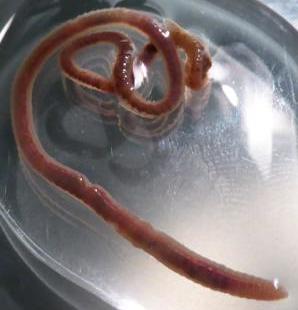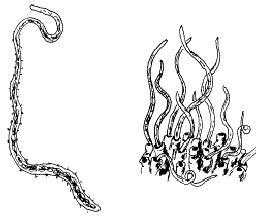
Oligochaeta is a subclass of animals in the phylum Annelida, which is made up of many types of aquatic and terrestrial worms, including all of the various earthworms. Specifically, oligochaetes comprise the terrestrial megadrile earthworms, and freshwater or semiterrestrial microdrile forms, including the tubificids, pot worms and ice worms (Enchytraeidae), blackworms (Lumbriculidae) and several interstitial marine worms.

The Lumbriculidae are a family of microdrile oligochaetes common in freshwater environments, including streams, lakes, marshes, wells and groundwater. They should not be confused with the earthworm family Lumbricidae. Many species and genera are highly endemic, mainly in Siberia and the western parts of North America. Lumbriculidae are the only family in the order Lumbriculida.

The Naididae are a family of clitellate oligochaete worms like the sludge worm, Tubifex tubifex. They are key components of the benthic communities of many freshwater and marine ecosystems. In freshwater aquaria they may be referred to as detritus worms.
Kudoa thyrsites is a myxosporean parasite of marine fishes. It has a worldwide distribution, and infects a wide range of host species. This parasite is responsible for causing economic losses to the fisheries sector, by causing post-mortem "myoliquefaction", a softening of the flesh to such an extent that the fish becomes unmarketable. It is not infective to humans.

Periphyton is a complex mixture of algae, cyanobacteria, heterotrophic microbes, and detritus that is attached to submerged surfaces in most aquatic ecosystems. The related term Aufwuchs refers to the collection of small animals and plants that adhere to open surfaces in aquatic environments, such as parts of rooted plants.
Lumbriculus genitosetosus was described by Holmquist in 1976 from almost 2,000 individuals collected in Northern Alaska. Initially, Holmquist revived the genus Thinodrilus for L. genitosetosus, Lumbriculus inconstans and Lumbriculus ambiguus on the basis of the Lumbriculus-species having only one pair of vas deferens and sperm funnels per atrium, whereas the Thinodrilus-species have two ; this division is, however, not generally recognised today, even if Thinodrilus may be a valid subgenus.
Rhynchelmis is the genus of 30 species of aquatic oligochaetes from the Northern Hemisphere, with 11 species from North America and 19 from Eurasia. They are part of the family Lumbriculidae, which are among the largest of the microdriles. They are generally defined as having atria in segment X and spermathecae in segment VIII. The prostomium generally has a proboscis, from which the genus has got its name.
Yamaguchia toyensis is one of many aquatic oligochaetes belonging to the family Lumbriculidae discovered on the island of Hokkaidō, Japan, which seems to be one of three "hotspots" of lumbriculid diversity. The genus named after the great oligochaete taxonomist Professor Hideji Yamaguchi.

Lumbriculus is a genus of oligochaete annelids.

Dioctophyme renale, commonly referred to as the giant kidney worm, is a parasitic nematode (roundworm) whose mature form is found in the kidneys of mammals. D. renale is distributed worldwide, but is less common in Africa and Oceania. It affects fish eating mammals, particularly mink and dogs. Human infestation is rare, but results in kidney destruction, usually of one kidney and hence not fatal. A 2019 review listed a total of 37 known human cases of dioctophymiasis in 10 countries with the highest number (22) in China. Upon diagnosis through tissue sampling, the only treatment is surgical excision.
Macrognathus is a genus of eel-like fish of the family Mastacembelidae of the order Synbranchiformes.

Velesunio ambiguus, the flood plain mussel, or the billabong mussel, is a species of freshwater bivalve in the family Hyriidae.

Hygrobia is a genus of aquatic beetles native to Europe, North Africa, China and Australia. It is the only genus in the family Hygrobiidae, also known as the Paelobiidae. These are known commonly as squeak beetles or screech-beetles.

Palaelodidae is a family of extinct birds in the group Phoenicopteriformes, which today is represented only by the flamingos. They were widespread during the Neogene, with fossil remains found on all continents other than Antarctica. The oldest remains referred to this group appeared in the fossil record during the Oligocene in Egypt and Belgium, before palaelodids reached their peak diversity during the Miocene. Following this the group declined in the early Pliocene before going extinct on most continents. However, remains found near Cooper Creek in the Lake Eyre Basin indicate that palaelodids managed to survive in Australia until the Pleistocene. Currently three genera are recognized by scientists: Adelalopus, Palaelodus and Megapaloelodus. Most fossil remains stem from Europe and have been assigned to the type species, Palaelodus ambiguus. Due to the fragmentary nature of most of these species, little is known about their ecology. They appear to have preferred brackish lakes and lagoons. Palaelodus has previously been thought to be a wader or diver, but recent research indicates that they were better suited for swimming and possibly fed on insect larvae and other aquatic invertebrates. At least Megapaloelodus appears to have adaptations for "locking" their legs in a standing position.
Eustrongylidosis is a parasitic disease that mainly affects wading birds worldwide; however, the parasite's complex, indirect lifecycle involves other species, such as aquatic worms and fish. Moreover, this disease is zoonotic, which means the parasite can transmit disease from animals to humans. Eustrongylidosis is named after the causative agent Eustrongylides, and typically occurs in eutrophicated waters where concentrations of nutrients and minerals are high enough to provide ideal conditions for the parasite to thrive and persist. Because eutrophication has become a common issue due to agricultural runoff and urban development, cases of eustrongylidosis are becoming prevalent and hard to control. Eustrongylidosis can be diagnosed before or after death by observing behavior and clinical signs, and performing fecal flotations and necropsies. Methods to control it include preventing eutrophication and providing hosts with uninfected food sources in aquaculture farms. Parasites are known to be indicators of environmental health and stability, so should be studied further to better understand the parasite's lifecycle and how it affects predator-prey interactions and improve conservation efforts.

Anochetus ambiguus is an extinct species of ant in the subfamily Ponerinae known from two possibly Miocene fossils found on Hispaniola. A. ambiguus is one of eight species in the ant genus Anochetus to have been described from fossils found in Dominican amber and is one of a number of Anochetus species found in the Greater Antillies.
Heterodrilus modestus is a species of oligochaete worm, first found in Belize, on the Caribbean side of Central America.
Limnodriloides sacculus is a species of clitellate oligochaete worm, first found in Belize, on the Caribbean side of Central America.
Smithsonidrilus is a genus of oligochaete worms.
Bathydrilus is a genus of clitellate oligochaete worms.









